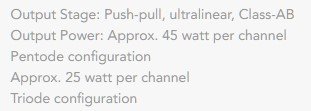Triode 25 - Unison Research - Official Website
I know very little about valve amps and am considering buying one. I see this well reviewed amp has an output impedance of 6 ohms... Is this before or after the transformer? I can't fathom a damping factor that ranges from 0.7-1.5 for my various speakers.
Is output impedance usually specified? If so is it usually before or after a transformer?
I know very little about valve amps and am considering buying one. I see this well reviewed amp has an output impedance of 6 ohms... Is this before or after the transformer? I can't fathom a damping factor that ranges from 0.7-1.5 for my various speakers.
Is output impedance usually specified? If so is it usually before or after a transformer?
Valve amps use high voltages low current. This make the primary of the transformer 2k-10k. The output impedance is after (secondary) the transformer.
It's not output impedance per se in this particular case, it's just the intended load impedance (there are lots of BS in their specs), so you basically can use any speakers in the 4-8 Ohm range with a single tap.
Its real output impedance is not specified.
Its real output impedance is not specified.
Beautiful Industrial Design there, wouldn´t expect less from an Italian company.
As of specs and performance, they are probably very good, why not?
Tube Technology has been mature and stable for decades now, everybody knows how to "do things right", it´s only doing what´s necessary (including $$$$) to achieve the goal.
No breakthrough new Technologies by any means, that´s why touting advantages in the Ads often resorts to irrelevant things or Mojo .
Not saying it´s the case here, sure it works as stated (as far as hard measuring is concerned) and certainly looks are stunning.
As of specs and performance, they are probably very good, why not?
Tube Technology has been mature and stable for decades now, everybody knows how to "do things right", it´s only doing what´s necessary (including $$$$) to achieve the goal.
No breakthrough new Technologies by any means, that´s why touting advantages in the Ads often resorts to irrelevant things or Mojo .
Not saying it´s the case here, sure it works as stated (as far as hard measuring is concerned) and certainly looks are stunning.
I suspect that the amp has just one output terminal pair - a 6 ohm one. Instead of offering both 4 and 8 ohm taps, some amps offer just one option that is half way between the two popular values.
The solution of one Zout is very smart.
With this value ( it is a simply ratio primary/secondary)
In this way you always use a full winding on secondary, then it is a middle value so the variable Z of a real load make the job of the tube less hard when this Z goes down.
The great Manley explain well the method of using all the space on secondary winding; he set the Z at 5 ohm on the best amps of VTL
Walter
Walter
With this value ( it is a simply ratio primary/secondary)
In this way you always use a full winding on secondary, then it is a middle value so the variable Z of a real load make the job of the tube less hard when this Z goes down.
The great Manley explain well the method of using all the space on secondary winding; he set the Z at 5 ohm on the best amps of VTL
Walter
Walter
I wonder if they mean the actual output impedance of the amplifier, or if they mean the nominal impedance of the secondary winding. They're not the same thing.
The impedance of the OPT secondary winding is a 'nominal' specification.
The impedance of your speaker is a 'nominal' specification. Real speakers have impedance that varies with frequency.
These nominal impedance specs are approximations.
The impedance of the OPT secondary winding is a 'nominal' specification.
The impedance of your speaker is a 'nominal' specification. Real speakers have impedance that varies with frequency.
These nominal impedance specs are approximations.
Last edited:
Thanks for the answers. I gather it's a single tap, optimized for 6 ohm speakers with an unspecified output impedance which should be low enough to drive any reasonable speakers.
I haven't measured, but I've read that my most often used speakers, are a very reasonable and easy load. It's a sealed box design with woofer Qes of 0.89, and Qtc (box +woofer) of a bit under 1.1 (ATC SCM20 Pro PSL Mk2)
I'm going to demo the amp when this stupid pandemic stops affecting things, see how they work together
I haven't measured, but I've read that my most often used speakers, are a very reasonable and easy load. It's a sealed box design with woofer Qes of 0.89, and Qtc (box +woofer) of a bit under 1.1 (ATC SCM20 Pro PSL Mk2)
I'm going to demo the amp when this stupid pandemic stops affecting things, see how they work together
I wonder if they mean the actual output impedance of the amplifier, or if they mean the nominal impedance of the secondary winding. They're not the same thing.
Likely because they can't speak and write in English properly. 😀
Likely because the specs were written by the marketing manager who has no clue about techLikely because they can't speak and write in English properly. 😀
According to them it is an ultralinear amplifier which has two modes - triode and pentode 😎
Attachments
Likely because the specs were written by the marketing manager who has no clue about tech
Being marketing manager is not an excuse. Actually is worse!
In Italian they are called in different ways too and it's clear what is an impedance and what is a connection.
- Home
- Amplifiers
- Tubes / Valves
- Output impedance 6 ohms??
